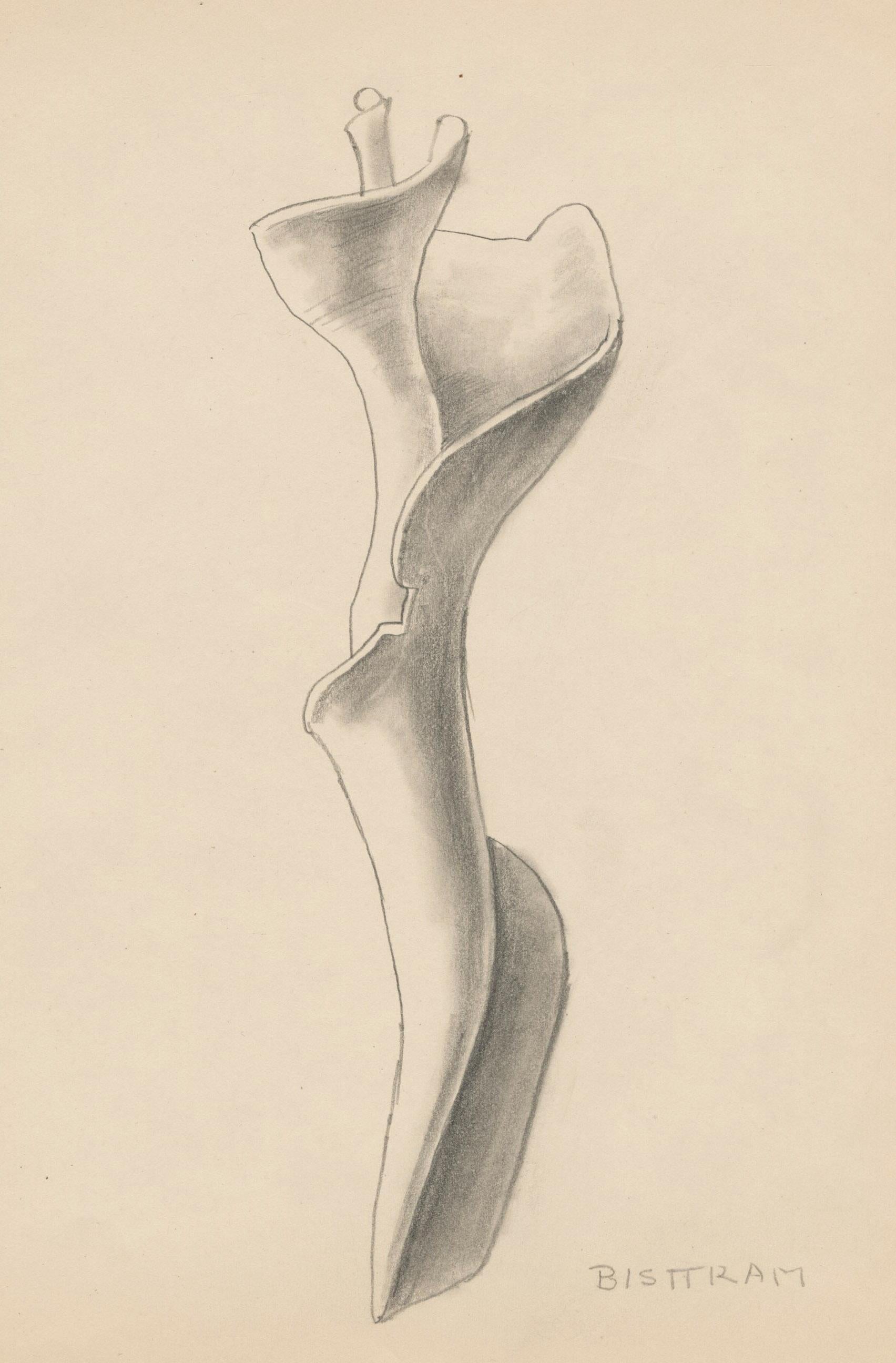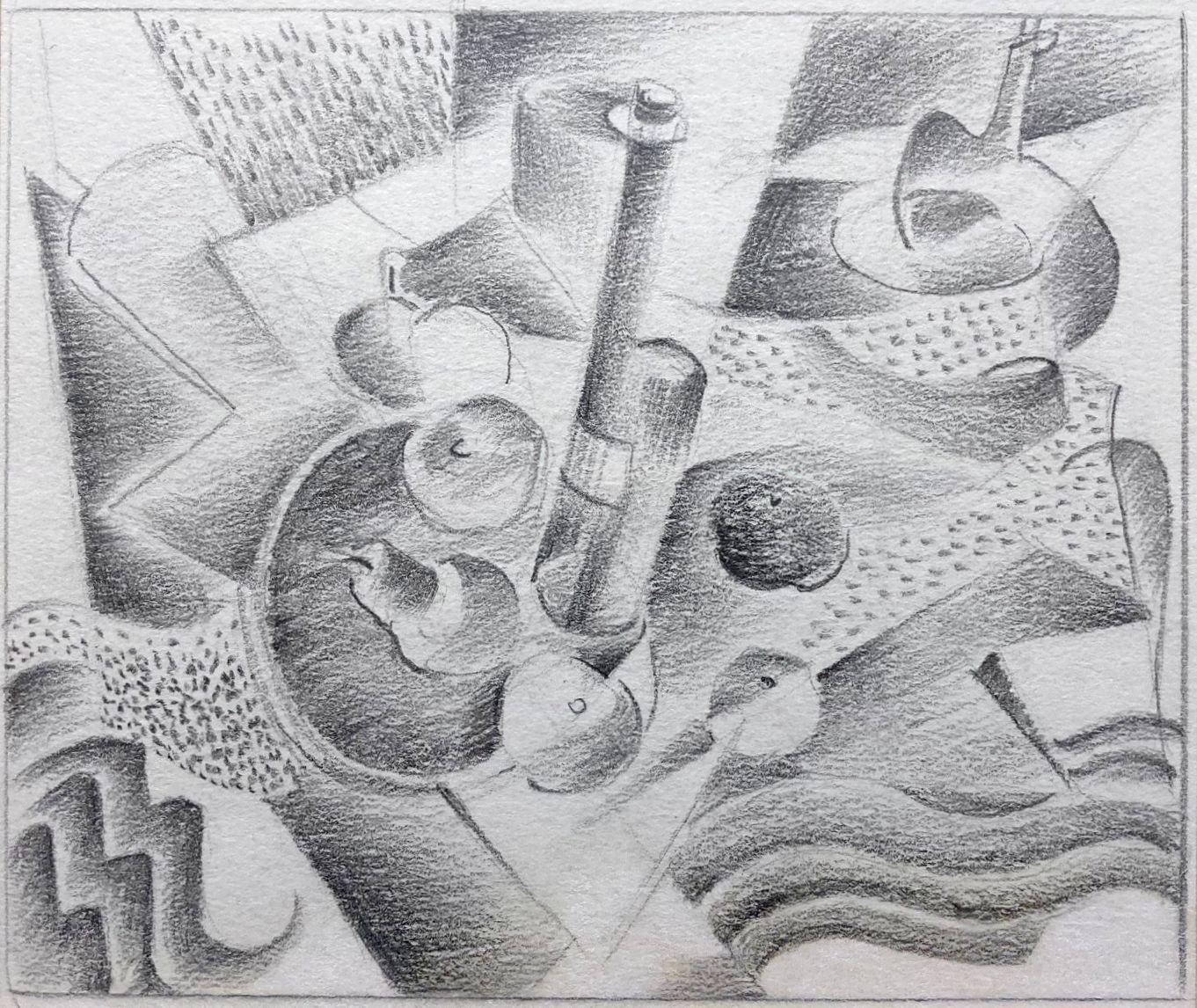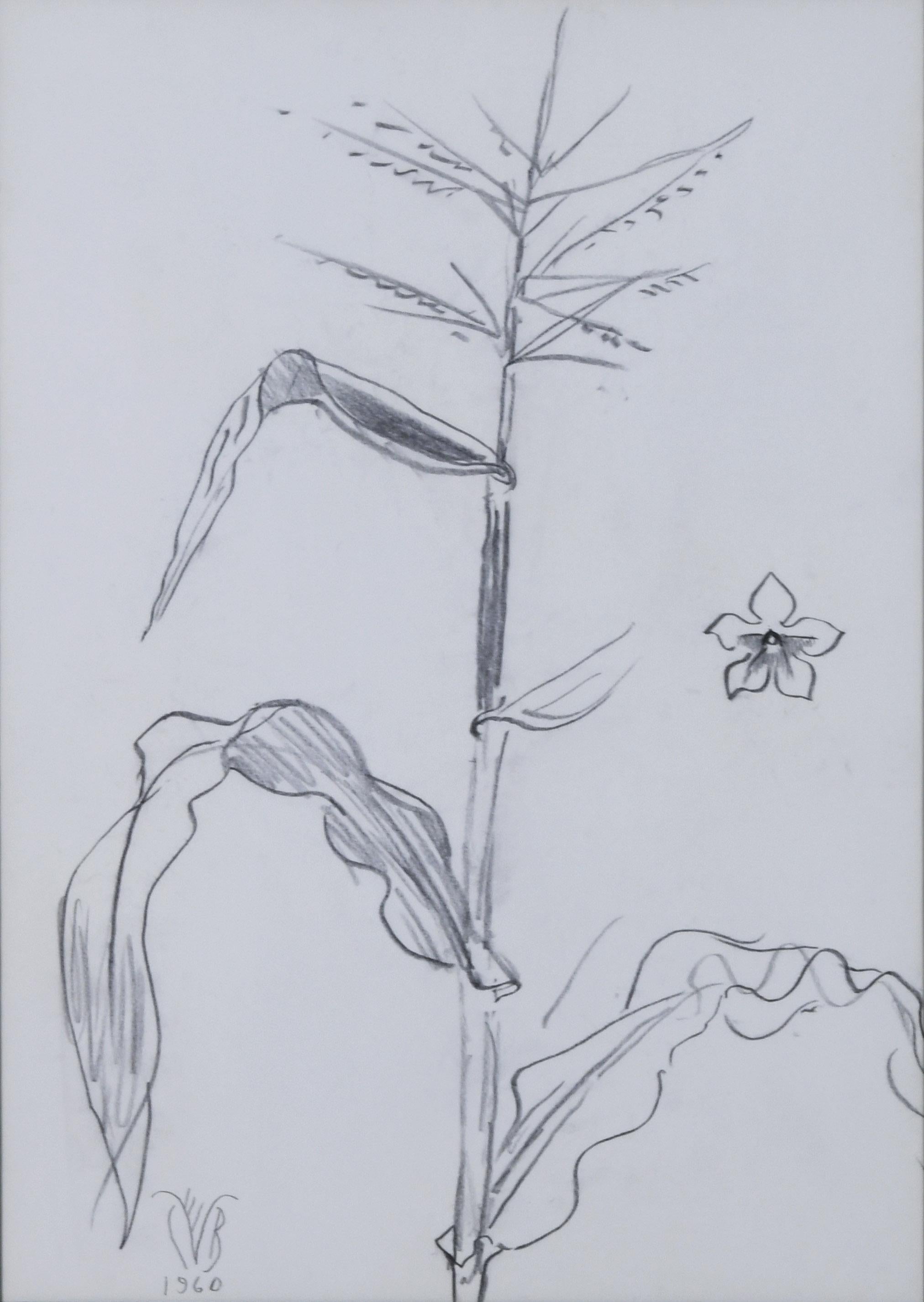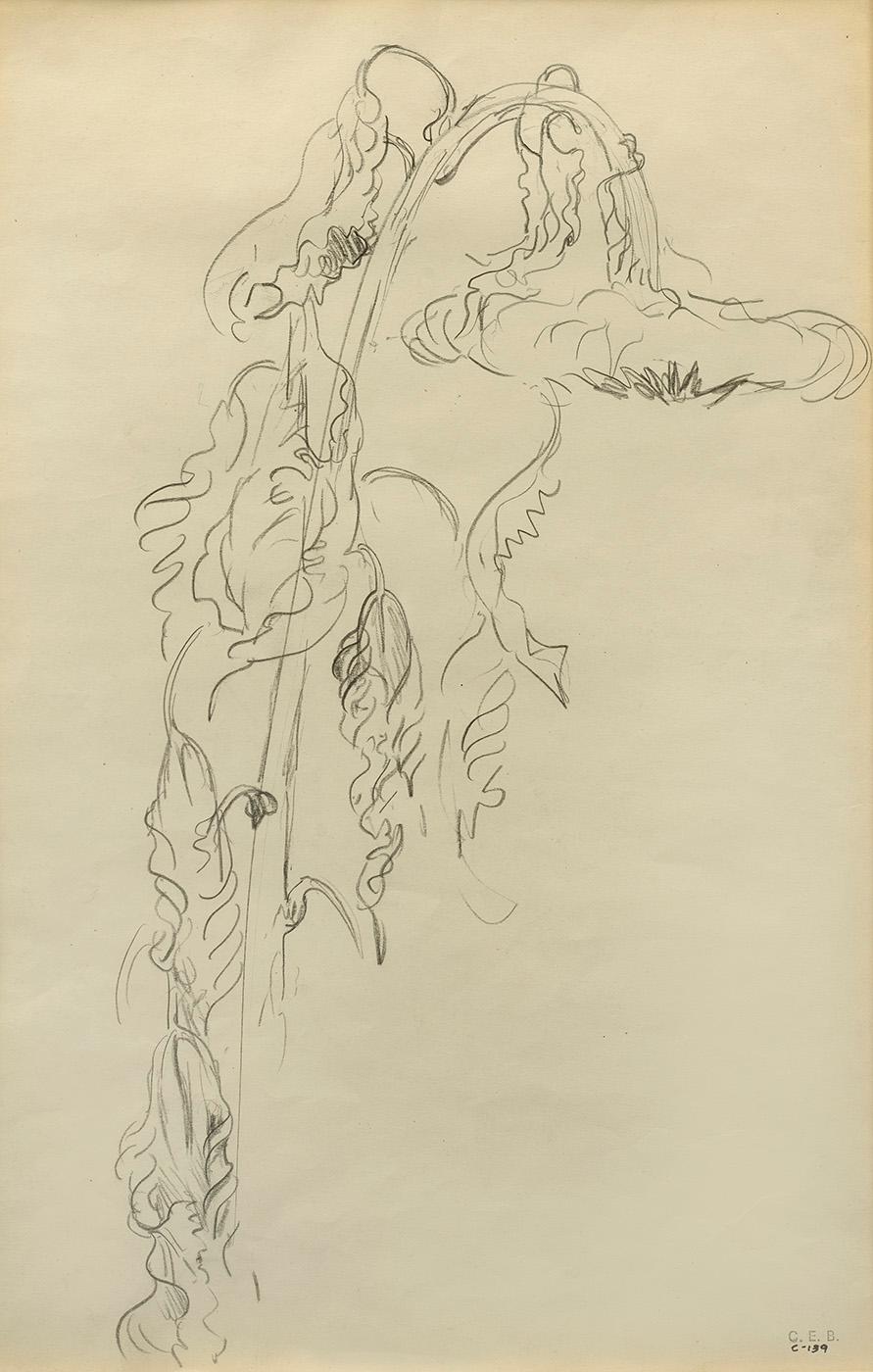Items Similar to Pencils and Pens
Want more images or videos?
Request additional images or videos from the seller
1 of 8
George RickeyPencils and Pens1987
1987
About the Item
Pencils and Pens
Graphite on paper, 1987
Signed and dated by the artist lower right (see photo)
Condition: Excellent
Image/Sheet size: 13 5/16 x 10 11/16 inches
Rickey, a noted kinetic sculptor, was born in South Bend, Indiana. His father moved the family to Scotland. Rickey studied art in England and became an excellent draftsman. He exhibited his drawings late in his career.
Rickey's drawing are rare, usually being preliminary designs for his sculptures. A finished drawing like this example shows the artist's draftsmanship.
"Born in South Bend, Indiana, in 1907, Rickey was raised near Glasgow, Scotland. His father, a mechanical engineer, managed the Singer sewing machine company's branch in Great Britain. Rickey read modern history at Balliol College, Oxford, took classes in drawing at the Ruskin School, then studied painting in Paris at André Lhote's academy and at the Académie Moderne with Fernand Léger and Amédée Ozenfant.
During the 1930s he painted first in a Cézannesque style, later in a Depression-era, social realist mode. He supported himself by teaching at Groton and at a series of colleges and universities.
In World War II Rickey served in the Army Air Corps, testing computing instruments used by bomber gunners. The work required both mechanical skill and understanding the effects of wind and gravity on ballistics, laying the foundation of his move from painting to kinetic sculpture.
Under the G.I. Bill, Rickey studied at the Institute of Fine Arts at New York University and from 1948-1949 attended the Institute of Design in Chicago, an outpost of Bauhaus teaching. Intrigued by both the history of constructivist art and by the mobiles of Alexander Calder, he began creating kinetic sculptures. In the 1950s and early 1960s, Rickey developed systems of motion for his sculpture that responded to the slightest variation in air currents. Over the next three decades he developed sculpture with parts made of lines, planes, rotors, volumes, and churns, moving in paths that change from simple oscillation to conical gyrations, describing a variety of planes or volumes. Many works during this period have been large-scale public commissions for sites in the United States, Europe, and Japan. Rickey died at his home in St. Paul, Minnesota, on 17 July 2002 at the age of 95." Courtesy National Gallery of Art
- Creator:George Rickey (1907-2002, American)
- Creation Year:1987
- Dimensions:Height: 13.94 in (35.41 cm)Width: 10.69 in (27.16 cm)
- Medium:
- Movement & Style:
- Period:
- Condition:
- Gallery Location:Fairlawn, OH
- Reference Number:
George Rickey
GEORGE RICKEY Born: South Bend, Indiana, 1907 Died: St. Paul, Minnesota, 2002 George Rickey spent over five decades committed to the creation of poetic and precisely-calibrated sculptures that he referred to as his “useless machines.” Of all the natural forces, it was the wind’s movement that most captured Rickey’s imagination. He once wrote, “The artist finds waiting for him, as subject, not the trees, not the flowers, not the landscape, but the waving of branches and the trembling of stems, the piling up or scudding of clouds, the rising and setting and waxing and waning of heavenly bodies.” Rickey began to devote himself to the investigation of motion in sculpture, producing dynamic works using simple geometric forms such as lines, squares, rectangles, circles, etc., in which his prodigious understanding of engineering and mechanics is demonstrable. Though the works enthusiastically collaborate with the interference of wind currents in their environment, the speed of their random movements are tempered by simple spacing and fixed arrangement of the elements. The relationship of the parts remains the same, but the dance is always changing. It is this tension that defines Rickey’s sculptures. “I think it’s important to make art that you have to wait for,” said the artist. As such, the works are able to oscillate gracefully through an infinite number of compositional iterations, engaging all aspects of the natural world around them—wind, light, rain, fog, or the lack thereof. Much of Rickey’s work was created in his studio in East Chatham, New York, where he settled in 1960. Prior to that time, the artist had lived and taught in Bloomington, IN; New Orleans, LA; New York, NY, and throughout the Midwest. His childhood, youth and college years were spent in Scotland and Britain. Aside from East Chatham he had studios in Berlin, Germany and Santa Barbara, CA. George Rickey's work is included in the permanent collections of over 150 museums worldwide, including the Hirshhorn Museum and Sculpture Garden, Smithsonian Institution, Washington, D.C.; Los Angeles County Museum of Art, California; Museum of Modern Art, New York; Metropolitan Museum of Art, New York; National Gallery of Art, Washington, D.C.; Walker Art Center, Minneapolis; National Gallery of Scotland, Edinburgh; Museum Boijmans Van Beuningen, Rotterdam and Kunstmuseum Bern, Switzerland, among many others. Key exhibitions include George Rickey: Monumental Sculptures on Park Avenue, New York (2021); A Life in Art: Works by George Rickey, Indianapolis Art Center, Indiana (2009); George Rickey: Kinetic Sculpture, A Retrospective, Vero Beach Museum of Art, Florida; Frederik Meijer Gardens and Sculpture Park, Grand Rapids and McNay Art Museum, San Antonio (2007-09); George Rickey: Kinetische Skulpturen, Museum für Kunst und Gewerbe, Hamburg, Germany (2003) and George Rickey – Retrospective Exhibition, Solomon R. Guggenheim Museum, New York (1979).
About the Seller
5.0
Recognized Seller
These prestigious sellers are industry leaders and represent the highest echelon for item quality and design.
Platinum Seller
These expertly vetted sellers are 1stDibs' most experienced sellers and are rated highest by our customers.
Established in 1978
1stDibs seller since 2013
713 sales on 1stDibs
Typical response time: 1 hour
Associations
International Fine Print Dealers Association
- ShippingRetrieving quote...Ships From: Fairlawn, OH
- Return PolicyA return for this item may be initiated within 10 days of delivery.
More From This SellerView All
- Untitled, Still Life of ShellLocated in Fairlawn, OHUntitled, Still Life of Shell Graphite on paper, 1945-1951 Signed lower right in pencil "Bisttram" (see photo) Condition: Excellent Sheet size: 9.63 x 7 .5 inches EMIL BISTTRAM (189...Category
1940s American Modern Still-life Drawings and Watercolors
MaterialsGraphite
- Study of Corn with NicotainaBy Charles E. BurchfieldLocated in Fairlawn, OHStudy of Corn with Nicotaina Signed with the artist's monogram and dated lower left Crayon on paper laid down on support paper by the artist Inscribed with title, date and dimensions...Category
1960s American Modern Still-life Drawings and Watercolors
MaterialsGraphite
- Flower StudiesBy Mary SpainLocated in Fairlawn, OHUnsigned Graphite and colored pencils on laid paperCategory
Mid-20th Century Surrealist Still-life Drawings and Watercolors
MaterialsGraphite, Color Pencil
- Untitled (cacti)By Peter MarksLocated in Fairlawn, OHProvenance: Estate of the Artist Peter Marks (1935 -2010) Peter Marks was born in New York City on January 18, 1935. A lifetime New Yorker, Marks gradu...Category
Early 2000s Abstract Geometric Still-life Drawings and Watercolors
MaterialsGraphite
- untitled (Still Life with Apples and Vase of Flowers)By William SommerLocated in Fairlawn, OH[recto];untitled (Sketches for Still Unsigned 9 1/2 x 12 inches (24.2 x 30.6 cm.)Category
20th Century Still-life Drawings and Watercolors
MaterialsGraphite
- Plum Branches and FlowersBy Joseph O'SickeyLocated in Fairlawn, OHPlum Branches and Flowers watercolor on wove paper, 1985 Signed and dated in pencil lower right corner From the artist's 1985 sketchbook Inspired by O'Sickey's love of Japanese and Chinese art and calligraphy. Provenance: Estate of the artist Condition: Excellent Image/Sheet size: 13 5/8 x 17 inches Joseph B. O’Sickey, Painter 1974 CLEVELAND ARTS PRIZE FOR VISUAL ARTS The title conferred on him by Plain Dealer art critic Steve Litt in a 1994 article, “the dean of painting in northeast Ohio,” must have pleased Joseph O'Sickey. It was more than 30 years since he had burst onto the local (and national) art scene. O’Sickey was already in his 40s in that spring of 1962 when he had his first one-man show at the Akron Art Museum and was signed by New York’s prestigious Seligmann Galleries, founded in 1888. In the decade and a half that followed, he would have seven one-man shows at Seligmann, which had showed the work of such trailblazing figures as Seurat, Vuilliard, Bonnard, Leger and Picasso, and appear in all of the group shows. O’Sickey took the Best Painting award in the 1962 May Show at the Cleveland Museum of Art (CMA). He and would capture the same honor in back-to-back May Shows in 1964 and ’65, and again in 1967. The remarkable thing, noted the Plain Dealer’s Helen Borsick, was that he accomplished this sweep in a variety of painterly styles, even using that most hackneyed of subjects, flowers. “The subject doesn’t matter,” he told her, “what the artist brings to it is the important thing.” O’Sickey’s garden and landscape paintings were big and bold, eschewing delicate detail in favor of vitality and impact. The great art collector and CMA benefactor Katherine C. White, standing before one of O’Sickey’s vivid garden paintings, compared the sensation to “being pelted with flowers.” Though he might represent an entire blossom with one or two smudged brush strokes or a stem with a simple sweep of green, O’Sickey rejected the moniker of Impressionist—or Pointillist or Abstract painter or Expressionist. “My work,” he said, “is a direct response to the subject. I believe in fervor and poetic metaphor. I try to make each color and shape visible and identifiable within the context of surrounding colors and shapes. A yellow must hold its unique quality from any another yellow or surrounding color, and yet read as a lemon or an object, by inference. It does not require shading or modeling—the poetic evocation is part of the whole.” “The subject,” O’Sickey used to tell his students at Kent State University, where he taught painting from 1964 to 1989, “has to be seen as a whole and the painting has to be structured to be seen as a whole.” He liked to think of it as “a process of controlled rapture.” When, in the 1960s, fond childhood memories drew him to the zoo, he found himself responding to the caged animals in their lonely dignity (or indignity) with sharp-edged, almost silhouette-like forms that evoked Matisse’s paintings and cut-paper assemblages. One observer was left with the impression that the artist had “looked at these animals, past daylight and into dusk when they lose their details in shadow and become pure shapes, with eyes that are seeing the viewer rather than the other way around. This is a world of shape and essence,” wrote Helen Borsick. “All is simplification.” O’Sickey attributed his ability to capture his subjects with just a few strokes—in an almost iconographic way—to a rigorous exercise he had imposed upon himself over a period of several months. Limiting his tools to a large No. 6 bristle brush and black ink, he set himself the task of drawing his pet parakeet and the other small objects in its cage (cuttlebone, feeding dish, tinkling bell) hundreds of times. The exercise gave him “invaluable insights into painting. . . . Because of the crudity of the medium, every part of these drawings had to be an invention and every mark had to have its room and clarity.” Then he began adding one color at a time—“still with the same brush and striving for the same clarity”—and headed off to the zoo where “the world opened up to me. I learned how little it took to express the subject.” Born in Detroit at the close of the First World War, O’Sickey grew up in St. Stanislaus parish near East 65th and Fleet on Cleveland’s southeast side. (The apostrophe was inserted into the family’s proud Polish name by a clerk at Ellis Island.) An early interest in drawing and painting may have been kindled by the presence on the walls of Charles Dickens Elementary School, one of only three grade schools in the district with a special focus on the arts, of masterful watercolors by such Cleveland masters as Paul Travis, Frank N. Wilcox and Bill Coombes. As a youngster O’Sickey took drawing classes at the Cleveland Museum of Art, and he and his brother spent hours copying famous paintings; while a student at East Tech High School in the mid-’30s, he attended free evening classes in life drawing with Travis and Ralph Stoll at the John Huntington Art and Polytechnic Institute, and Saturday classes at the Cleveland School (later the Cleveland Institute) of Art, where he earned his degree in 1940 under the tutelage of Travis, Stoll and such other legendary figures as Henry Keller, Carl Gaertner, William Eastman, Kenneth Bates...Category
1980s Contemporary Still-life Drawings and Watercolors
MaterialsWatercolor
You May Also Like
- Still LifeBy Stanley BieleckyLocated in Chicago, ILA Cubist black & white graphite drawing of fruit by artist Illinois and Michigan artist Stanley Bielecky.Category
1940s American Modern Drawings and Watercolor Paintings
MaterialsGraphite
- Untitled (Study of Classical Drapery)By Jan MatulkaLocated in Chicago, ILA graphite on paper, study of a classical drapery by artist Jan Matulka. The image is drawn on the back of a typewritten, folded sheet of stationery, from Dyer, Hudson & Co., New Yo...Category
1930s American Modern Still-life Drawings and Watercolors
MaterialsPaper, Graphite
- Two Wood Ducks on a Flowering BranchBy Joseph StellaLocated in New York, NYJoseph Stella was a visionary artist who painted what he saw, an idiosyncratic and individual experience of his time and place. Stella arrived in New York in 1896, part of a wave of Italian immigrants from poverty-stricken Southern Italy. But Stella was not a child of poverty. His father was a notary and respected citizen in Muro Locano, a small town in the southern Appenines. The five Stella brothers were all properly educated in Naples. Stella’s older brother, Antonio, was the first of the family to come to America. Antonio Stella trained as a physician in Italy, and was a successful and respected doctor in the Italian community centered in Greenwich Village. He sponsored and supported his younger brother, Joseph, first sending him to medical school in New York, then to study pharmacology, and then sustaining him through the early days of his artistic career. Antonio Stella specialized in the treatment of tuberculosis and was active in social reform circles. His connections were instrumental in Joseph Stella’s early commissions for illustrations in reform journals. Joseph Stella, from the beginning, was an outsider. He was of the Italian-American community, but did not share its overwhelming poverty and general lack of education. He went back to Italy on several occasions, but was no longer an Italian. His art incorporated many influences. At various times his work echoed the concerns and techniques of the so-called Ashcan School, of New York Dada, of Futurism and, of Cubism, among others. These are all legitimate influences, but Stella never totally committed himself to any group. He was a convivial, but ultimately solitary figure, with a lifelong mistrust of any authority external to his own personal mandate. He was in Europe during the time that Alfred Stieglitz established his 291 Gallery. When Stella returned he joined the international coterie of artists who gathered at the West Side apartment of the art patron Conrad Arensberg. It was here that Stella became close friends with Marcel Duchamp. Stella was nineteen when he arrived in America and studied in the early years of the century at the Art Students League, and with William Merritt Chase, under whose tutelage he received rigorous training as a draftsman. His love of line, and his mastery of its techniques, is apparent early in his career in the illustrations he made for various social reform journals. Stella, whose later work as a colorist is breathtakingly lush, never felt obliged to choose between line and color. He drew throughout his career, and unlike other modernists, whose work evolved inexorably to more and more abstract form, Stella freely reverted to earlier realist modes of representation whenever it suited him. This was because, in fact, his “realist” work was not “true to nature,” but true to Stella’s own unique interpretation. Stella began to draw flowers, vegetables, butterflies, and birds in 1919, after he had finished the Brooklyn Bridge series of paintings, which are probably his best-known works. These drawings of flora and fauna were initially coincidental with his fantastical, nostalgic and spiritual vision of his native Italy which he called Tree of My Life (Mr. and Mrs. Barney A. Ebsworth Foundation and Windsor, Inc., St. Louis, illus. in Barbara Haskell, Joseph Stella, exh. cat. [New York: Whitney Museum of American Art, 1994], p. 111 no. 133). Two Wood Ducks...Category
20th Century American Modern Still-life Drawings and Watercolors
MaterialsColor Pencil
- Sunflower StudyBy Charles E. BurchfieldLocated in New York, NYEstate stamp lower right: C-139Category
Early 20th Century American Modern Still-life Drawings and Watercolors
MaterialsPaper, Pencil
- Blanche Grambs, (Cooking Still Life: Bread, Olives, Potato, Mushrooms)Located in New York, NYIn the 1950s and 60s Grambs worked on many commissions. This drawing was probably for a magazine, perhaps House and Garden or House Beautiful. It is signed and dated in pencil on the...Category
Mid-20th Century American Modern Figurative Drawings and Watercolors
MaterialsInk, Pencil
- UNTITLED No. 26Located in New York, NYAvant-Garde ArgentineCategory
1970s American Modern Still-life Drawings and Watercolors
MaterialsPaper, Pencil, Watercolor, Charcoal, Conté






